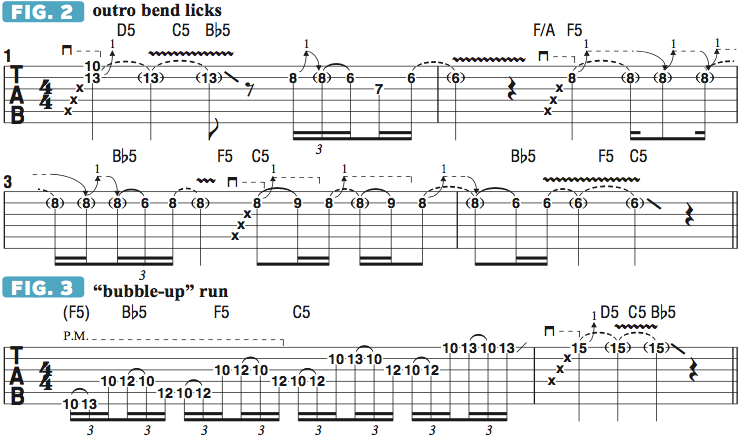Crafting Wailing Lead Phrases
Last month, I detailed the main rhythm guitar parts I play in Rascal Flatts’ cover of the Tom Cochrane song “Life Is a Highway,” which we had recorded back in 2006 for the Disney/Pixar animated film Cars and subsequently included as a bonus track on our album Me and My Gang.
This month I’d like to talk about some of the lead licks I play in the song, which were born in the studio and have since evolved somewhat over the course of countless live shows.
“Life Is a Highway” was the first song for which we had the opportunity and honor to work with legendary producer Dan Huff, who is also an awesome guitarist with renowned country and hard rock credentials.
Dan’s creative guidance with our arrangement proved invaluable, helping to make the song one of our biggest hits and kind of a heartland-rock anthem that has since become a concert staple for us. The song has such great energy and really gets audiences on their feet, which is why we like to save it for the end of our set, as a climactic grand finale.
FIGURE 1 shows the latest evolution of my solo, which comes right after the song’s subdued bridge section that we looked at last month. The transition coming out of the bridge creates a strong buildup to the solo, which is played over the chorus power-chord progression and is a flat-out screaming hard rock lead. The solo is based primarily on D minor pentatonic (D F G A C), with lots of blues-rock elements, such as muted string rakes, bends, pull-offs and some bold vibratos.

I kick off the solo with a long, ascending barred finger slide and lay into a unison bend on the high D root note, which I repeat a few times for emphasis. I follow this in bar 2 with some stock pentatonic bends and pull-offs and a hearty vibrato. In bar 3, I jump down to first position momentarily and play a twangy B-string bend, from the D root note up to the second/ninth, E, and let it hang in the air for a couple of beats before releasing it. I then zoom up to 13th position in bar 5 and do some high, wailing bends and pre-bend/releases on the high E string’s 15th fret. When performing the bend vibrato in bar 5, hold the bend for a couple of beats, as indicated, to establish the target pitch before proceeding to shake it. Try to make the vibrato wide, even and smooth. I end the solo in bars 7 and 8 with some string skipping and fast 16th-note triplets, using hammer-ons, pull-offs and quick finger slides to create a nice balance between staccato (picked) and legato (slurred) articulations.
When we get to the song’s final, repeated chorus, it’s like the proverbial ship has set sail and everything is now wide open, and that always feels like the ideal climactic moment in our live show for me to put the pedal to the metal, flick on my bridge pickup and do some shredding, as the energy level onstage is sky-high at that point. FIGURE 2 shows some slinky, Eddie Van Halen–style bend licks I like to play over the outro chorus, conscientiously phrased around the vocals, and FIGURE 3 is a Steve Morse–inspired ascending 16th-note-triplet run that incorporates string skipping within the 10th-position D minor pentatonic “box” shape. I, in my country-boy speak, like to call this kind of run a “bubble-up.”
Get The Pick Newsletter
All the latest guitar news, interviews, lessons, reviews, deals and more, direct to your inbox!

“Such a rare piece”: Dave Navarro has chosen the guitar he’s using to record his first post-Jane’s Addiction material – and it’s a historic build
“The best guitar player I ever heard”: Nashville guitar extraordinaire Mac Gayden – who worked with Bob Dylan, Elvis, Linda Ronstadt and Simon & Garfunkel – dies at 83




![[from left] George Harrison with his Gretsch Country Gentleman, Norman Harris of Norman's Rare Guitars holds a gold-top Les Paul, John Fogerty with his legendary 1969 Rickenbacker](https://cdn.mos.cms.futurecdn.net/TuH3nuhn9etqjdn5sy4ntW.jpg)





